

Implemented Actions since the HLC 2002
Visit
In view of the suggestions given by the visiting team concerning
criterion three of the 2002 self-study, the assessment committee
reconvened with a renewed desire to create a comprehensive,
faculty-driven, institution-wide plan that focused on using
authentic means of assessing student achievement. The committee
decided to work on two areas of immediate concern: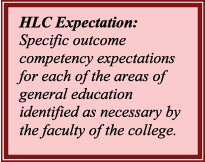
-
a perceived lack of clearly-defined general education objectives agreed upon by faculty, and
-
specific goals for transfer and career programs which incorporated course outcomes that were aligned to the mission of the College.
General Education Competencies (2002-2003)
To achieve the first goal, faculty were approached during a May 2002 faculty forum and asked to discuss those elements that should be part of any program deigned “general education. Faculty were charged with the question: What should graduates be able to do? From the generalized list created that day, faculty were polled to determine the most common competencies that were both taught and expected by instructors in classes across the College.
In August 2002, the fall in-service focused on assessment, and
faculty reviewed the existing general education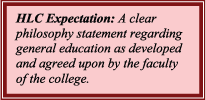 competencies and refined the new proposed
competencies. During the 2003 spring semester faculty approved the
six major general education competencies: communications,
problem-solving, quantitative skills, research, ethics, and
technology. Cross-discipline teams were formed and met during
faculty forums to discuss the new competencies and identify
specific objectives for each. In March 2003, faculty completed
General Education Alignment Forms, which asked faculty to identify
from the list of six which competencies they taught and assessed in
their classrooms. & These data were aggregated to determine
coverage and breadth of the described competencies and
objectives.
competencies and refined the new proposed
competencies. During the 2003 spring semester faculty approved the
six major general education competencies: communications,
problem-solving, quantitative skills, research, ethics, and
technology. Cross-discipline teams were formed and met during
faculty forums to discuss the new competencies and identify
specific objectives for each. In March 2003, faculty completed
General Education Alignment Forms, which asked faculty to identify
from the list of six which competencies they taught and assessed in
their classrooms. & These data were aggregated to determine
coverage and breadth of the described competencies and
objectives.
From these six competencies, and from the prior general education statement in the catalog description of our distribution requirements, the Core Team created the general education philosophy statement, which reads as follows:
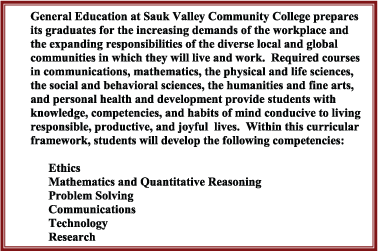
Transfer and Career Program Goals (2003-04)
Once the faculty had established and refined the general education philosophy and competencies, the next step was to develop a practical, simple, and effective way to collect consistent data about general education and transfer and career goals at all program levels. In the fall of 2003, the Assessment Committee was charged by the Vice President of Instructional Services with developing a systematic method of collecting program data. The first step was to conceptualize the data streams from classroom to degree.
Illustration 12: 2003 Institutional Goals and
Data Flow Chart
The decision was made at that time to continue administering the CAAP exam for longitudinal purposes. For internal program data, it was determined that the committee would proceed from an established model, thus ensuring the likelihood that the model would have resource material and previous examples of successful implementation. Of particular concern to the committee was that the model be flexible enough to allow faculty to determine what assessment tools and events would be best suited to their particular content-area objectives, without compromising the ability of the collected data to be aggregated for inclusion in the discipline, area, and program levels.
The committee eventually agreed that the basic model given in James Nichols’ A Practitioner’s Handbook for Institutional Effectiveness and Student Outcomes Assessment Implementation4 would provide the groundwork for further development of the plan. The model fulfilled two objectives of the committee: it provided data for multiple levels of instruction and program analysis, as well as created an expectation for using the results of assessment events to make measurable change in instruction and practice. The committee felt strongly that most faculty were already using assessment instruments to measure student learning outcomes, albeit likely that faculty hadn't considered their objectives and measures as part of the larger plan of institutional assessment. The committee believed that faculty ownership, and subsequently faculty buy-in to the assessment process, would be greatly advanced if faculty were allowed to continue to use instruments they were comfortable with, or develop instruments which fulfilled both the needs of the data collection process as well as the needs of the instructor in daily classroom management. The Nichols model allowed for variation without sacrificing cross-discipline and cross-college investigation.
In October 2003, it was determined that the bulk of the remaining design work was largely focused on academic issues, and the assessment committee created a sub-committee with just faculty representatives. This Core Team was charged with designing and maintaining the assessment system.
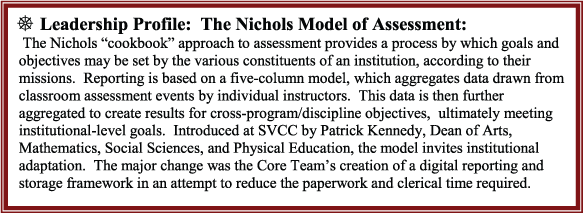
4 Nichols, James, A Practitioner’s Handbook for Institutional Effectiveness and Student Outcomes Assessment Implementation, 3rd ed. (New York: Agathon Press, 1995).
In January 2004, the Assessment Committee introduced the first
version of an assessment
reporting template that allowed faculty to consider their
courses, disciplines, and areas from two major perspectives ![]() :
:
1. The template required identification of either a transfer goal or career goal, depending upon the focus of the discipline. From that overarching goal, faculty members were asked to identify those specific objectives used to ensure students met those goals. For each objective, faculty were then asked to identify what assessment tool or event would determine if students had met the stated objectives. Finally, faculty members were asked to identify the criteria that constituted success based on their instrument of choice.
2. The template required that faculty identify what general education competencies were being assessed in their classes. For each competency identified, faculty members were asked to identify an instrument they used to measure student success in performing the described competency, and to elaborate on what constituted the criteria for success based on their chosen instrument.
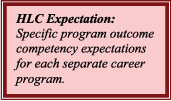 Each discipline and area plan incorporates
objectives that have been agreed upon by faculty in that discipline
and area. The objectives reflect the most common thread of the
individual instructors's objectives, which bridges the gap between
instructors teaching and assessing in isolation, and the
collaboration of faculty in determining how best to approach
instruction at all levels. Aggregation of data relating to the
criteria for success or lack thereof from the individual plans
establishes whether or not disciplines and areas are meeting their
common objectives.
Each discipline and area plan incorporates
objectives that have been agreed upon by faculty in that discipline
and area. The objectives reflect the most common thread of the
individual instructors's objectives, which bridges the gap between
instructors teaching and assessing in isolation, and the
collaboration of faculty in determining how best to approach
instruction at all levels. Aggregation of data relating to the
criteria for success or lack thereof from the individual plans
establishes whether or not disciplines and areas are meeting their
common objectives.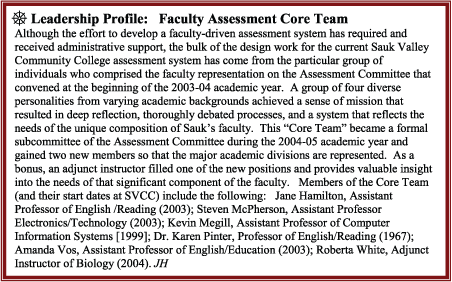
This model served two purposes which the committee agreed were equally important: on the one hand, data collected can be in any initial form which allows significant latitude for qualitative assessment, a process which many felt is much more vested and authentic than measures which are always statistically quantifiable. On the other hand, translating the initial data into more easily quantifiable “measures of success†based on common criteria allows the institution to follow the thread of student academic achievement from the individual classroom all the way to the mission of the institution in a manageable way that can be summarized for presentation. The plan, essentially, allows for both reflection and improvement at the course level as well as the institutional level, without compromising the integrity or effectiveness of either.
During that spring, deans began meeting individually with instructors and discipline groups to facilitate the development of the course objectives. The Core Team, meanwhile, began designing the first data collection forms, with the goal of creating a digital assessment system to avoid a cumbersome paper-based system. By the end of the 2004 spring semester, plans were underway to begin the data collection cycle. That March, the president approved funding for release time for the Core Team to manage the increasing workload.
Summer of 2004—Connecting Processes and Bringing Faculty Together
The summer of 2004 was the most expansive growth period for the
assessment system” the College's reorganization into a learning
college created procedures and policies which formalized the
proposed assessment system. Membership and duties for the various
committees and subcommittees were articulated and documented. The
Core Team, newly expanded to six members, introduced the new
intranet server (known locally as the Assessment Folder) to house
the assessment report forms and revised templates and data
collection forms. ![]() The
Core Team also proposed the addition to the developing committee
structure of a General Education Subcommittee, whose main purpose
was to collect and report results from the ongoing CAAP testing
process, as well as to collect aggregate general education data
from classroom report forms. Each faculty member received a copy of
the Academic Assessment Handbook for Faculty: An Introduction
to the System (
see Appendix O). An assessment resource room was
established and a collection of resource materials made available
for faculty use.
The
Core Team also proposed the addition to the developing committee
structure of a General Education Subcommittee, whose main purpose
was to collect and report results from the ongoing CAAP testing
process, as well as to collect aggregate general education data
from classroom report forms. Each faculty member received a copy of
the Academic Assessment Handbook for Faculty: An Introduction
to the System (
see Appendix O). An assessment resource room was
established and a collection of resource materials made available
for faculty use.
In June, consultant Regis McCord gave a faculty workshop on using rubrics in assessment events. In July, administrators and faculty members who attended the Nichols Institutional Effectiveness Institute brought back an increased awareness of how the academic assessment stream feeds into the strategic planning process. The Core Team noted that adaptations made to the Nichols model were in the best interests of the Sauk community and increased the institution's ownership of the process. At this time, it was determined that the success of the assessment program relied on having representatives from each area who would be able to organize and communicate with faculty about the data collection process and subsequent discussion and implementation of instructional improvement. The nine Area Facilitator positions were created, and the facilitators were given training on the system to allow them to better help their faculty through the first data collection cycle.








